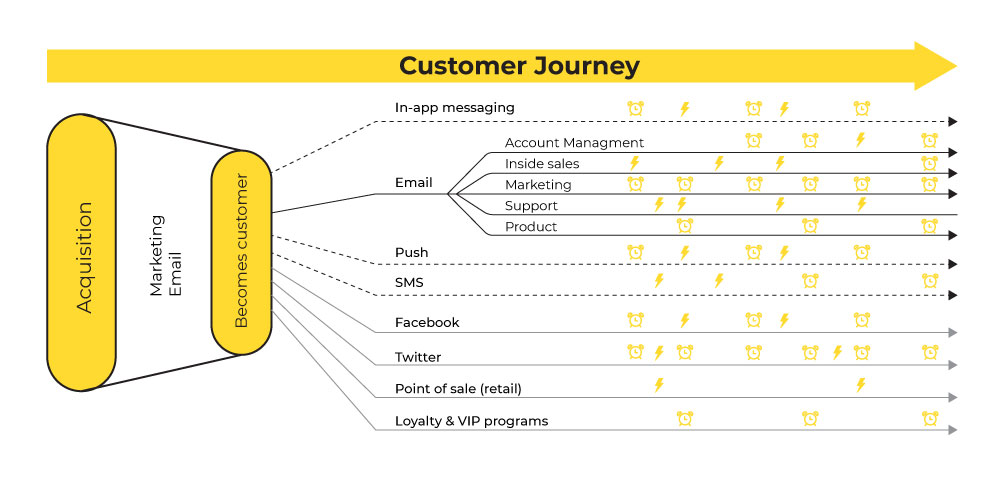Customer experience is what people share with their peers about your brand. It is like you have written an exam and they are the judges.

The first step to creating a memorable customer experience is putting yourself in the customers’ shoes and seeing through their eyes. Customer journey maps come into play at this point.
The cardinal objective of customer journey mapping is to work as a mirror to show you the customer’s experience with your brand. It also gives you an insight into the objections that stop them from purchasing (again) from you. It is possible to improve the customer experience only after understanding the existing customers’ perspectives.
Have you heard about market orientation? It means that you are in sync with your customers and what they think, believe, feel, and want. It looks like a cakewalk on the surface and every brand seems to be doing it. But when you dive deeper, you realize that we are suffering from the cognitive bias of “in-group favoritism”. We form a specific worldview and limit ourselves within an auditorium of like-minded people. We assume that everyone shares the same point of view as us and forget the element of empathy. Customer journey mapping helps us redeem it. As a result, we can improve communications and processes more meaningfully.
What is a Customer Journey Map?
A tool that helps marketers identify, organize, verify, and socialize the customer experience is known as a customer journey map. It also allows marketers to understand customer needs and figure out gaps in the customer experience. Then, you can utilize these learnings to fill these gaps with effective solutions.
A customer journey map gives you a visual perspective of how a customer interacts with your business. In simple words, a customer journey map works like a microscope for the purchase process and allows you to streamline the customer experience while warranting long-term customer success.
Challenges in creating a customer journey map
According to the rule of seven, a customer has an average of seven interactions before they decide to make a purchase. They engage with businesses across multiple channels and devices. It includes organic search, social media, and referral sites. Every customer interaction needs to be perfectly identified to prepare a perfect customer journey map.
ENTER MARKETO ↵
Marketo furnishes a powerful scaffold to create effective customer journey maps and speed up the deal velocity across different stages.
Your customer journey map could look something like this:

Advantages of Customer Journey Mapping in Marketo
- You can recognize bottlenecks and prevent them
Customer journey mapping helps you track and quantify the number of customers in every stage. Accordingly, you can recognize possible bottlenecks between stages.
- It helps formulate the marketing strategy to drive conversions
Customer mapping allows you to design the marketing strategy in such a way that you can move the customers closer to conversions. You can spare enough time to understand the customer interactions and make necessary iterations. The customer journey throws light on the customer’s pain points at different stages of the purchase process. Accordingly, companies can reduce friction and objections to drive conversions faster. Drawing insights from the customer map will enable you to allocate the budget to things that are most important for business growth. Through the Marketo customer journey map, you will be able to connect the lead and account program data. It will let you see how customers are proceeding in the funnel. In case you detect any low-performing stages, you can channel your sales and marketing efforts in that direction. It will also improve the accountability between the sales and marketing departments by using timed stages.
- You can impart a consistent experience to customers
As customer journey maps let you see the world from their eyes, you can figure out the gaps in customer experience. Consequently, you can ensure a pleasant customer experience by optimizing customer service management. If there is any discrepancy between the desired and real customer experience, you can overcome it through customer maps.
- It allows you to take a futuristic approach
Creating customer journey maps will help you understand how customer interactions change over time. They help in tracking the dynamics of customer expectations and adjusting your marketing strategy accordingly.
A Step-by-step Guide to Customer Journey Mapping
- Define your goals
Everything in business comes with a “why”. Customer journey mapping is no different. Identify your goals and the type of customers you want to target. Your customer journey maps will determine the future processes. So, make sure you give enough time to this step.
- Collect user information
After you determine the objectives, you must collect all the necessary customer information. Every customer interaction should be recorded. Make sure you include qualitative and quantitative data in the customer journey map. Cross-departmental information will be of great help while preparing the customer journey map.
- Prepare customer personas
In addition to the information gathered from the second step, use questionnaires and surveys to create detailed customer personas.
You can include questions like:
1. How did you come to know about us?
2. Why did you choose us?
3. Was our website easy to navigate?
4. How was your interaction with the customer support team?
5. What are the main challenges that made you purchase from us?
6. Do you have any suggestions on how we can improve our products/ services?
Note that you will be able to create a number of customer personas with these surveys. However, you must focus on one or two for the customer journey maps to be effective. Marketo gives you the functionality to design customer lifecycle models more effectively with their drag and drop model builder, templates and custom models, and model management and cloning
- Acknowledge all touchpoints
Touchpoints are the channels that your customers interact on. Whether it is opening an email, clicking through a link in a newsletter, liking or commenting on a social media post, or adding an item to the cart — all these are considered touchpoints. If you are a Marketo user, you will get to use lifecycle phases, stages, and transitions to structure linear as well as complex success paths. You can track the customer traffic for every stage and then automate the transitions between two phases.
- Multiple Phase, Stage & Transition Types
- Anonymous Visitor Stage & Tracking
- Lifecycle Stage Transition Automation
If you think that your customers are not interacting with adequate touchpoints, your website is not effective enough to drive a decision. Contrarily, if there are too many touchpoints, it means that your website is difficult to navigate through and there are too many roadblocks to conversion.
- Choose the type of map
According to the goals you have determined, you can choose the type of customer journey map.
They are of three different types.
a. Current state
This is the most commonly used map. It lets you perceive the actions, thoughts, behaviors, and emotions that your customers experience at the moment.
b. Day-in-the-life
As the name suggests, this type of map helps to understand the customer’s habits and activities throughout the day. It may or may not include the brand interaction.
c. Future state
The future state customer map predicts the actions, thoughts, behaviors, and emotions experienced by your customers in the future interactions with your brand.
- Plot the customer journey
By now, you have a clear picture of your target audience and customers. The next step is to plot the customer journey. You must concentrate only on the actions in this step and the time when they take those actions.
- Experience the customer journey hands-on
Take the customer journey as you have plotted in the previous step. Note down the customer’s challenges and instances when you have to look hard for the information you need. Determine whether you are getting the experience you expect for your clients. Assess the actions that your customers would take and the reasons for the same.
This experience will help you understand if your customer’s needs are met. It will help you ensure delivering a useful and intuitive experience to the customers by solving their problems. It will add a personal touch to all the engagements and instill trust in their minds.
Wrapping Up
To sum it up, a basic customer journey map would look something like this:

According to your industry, you can include additional layers of tracking on this map. Just make sure that you do not consider microscopic interactions and add only critical digital interactions to the list.
If you need any help, our Marketo experts are always there to help you.






Disha Bhatt (Dave)
Latest posts by Disha Bhatt (Dave) (see all)
How to Create Dynamic Content with Content Builder in Salesforce Marketing Cloud: A Step-by-step Guide
Expert Interview Series: Part 6